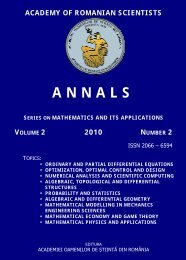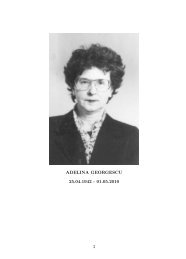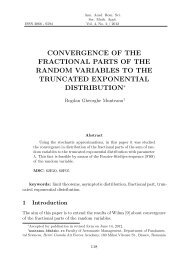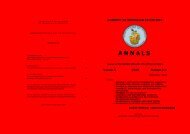3 - Mathematics and its Applications
3 - Mathematics and its Applications
3 - Mathematics and its Applications
Create successful ePaper yourself
Turn your PDF publications into a flip-book with our unique Google optimized e-Paper software.
60 Mitrofan M. Choban, Laurențiu I. Calmuțchi7 Dilations of E-metric spacesFix an m-scale E.Let (X, d, E) be an E-metric space.A mapping f : X −→ X is a dilation mapping if there exist an elementq ∈ E (+,1) <strong>and</strong> an element k ≥ 0 such that q · k = 1 <strong>and</strong> d(f(x), f(y)) =k·d(x, y) for all x, y ∈ X. Every dilation mapping f is a uniformly continuoushomeomorphism <strong>and</strong> f −1 is a contraction with the Lipschitz constant q ∈E (+,1) .From Corollary 3.2 it followsCorollary 7.1. Let (X, d, E) be a sequentially complete E-metric space<strong>and</strong> f : X −→ X be a dilation mapping. Then the mapping f adm<strong>its</strong> one<strong>and</strong> only one fixed point b ∈ X. Moreover, b = lim n→∞ n(x, f −1 ) for anypoint x ∈ X.8 On M-complete multi-metric spacesWe say that the pseudo-metric d on a space X is M-complete if it is continuous,the metric space (X/d, ¯d) is complete <strong>and</strong> the sequence {x n : n ∈ N}has an accumulation point provided lim n→∞ d(x, x n ) = 0 for some x ∈ X.Remark 8.1. The pseudo-metric d on a space X is M-complete if<strong>and</strong> only if the metric space (X/d, ¯d) is complete <strong>and</strong> the projection π d :X −→ X/d is a continuous closed mapping with the countably compactfibers π −1d(u). Thus a space with a complete pseudo-metric is an M-space[20]. The spaces related to M-spaces were studied in [4, 5, 9, 10].A multi-metric space (X, P) is said to be an M-complete multi-metricspace if there exists some M-complete pseudo-metric d ∈ P. Denote by s(P)the set of all M-complete pseudo-metrics d ∈ P.Theorem 8.2. Any M-complete multi-metric space (X, P) is sequentiallycomplete.Proof. Fix d ∈ s(P). Let L = {x n ∈ X : n ∈ N} be a fundamentalsequence. Since the metric space (X/d, ¯d) is complete, there exists a pointb ∈ X such that lim n→∞ d(b, x n ) = 0. In this case F = {x ∈ X : d(b, x) = 0}<strong>and</strong> H = F ∪ L are countably compact closed subsets of the space X. Thusthe sequence {x n : n ∈ N} is convergent in the subspace H. The proof iscomplete.






